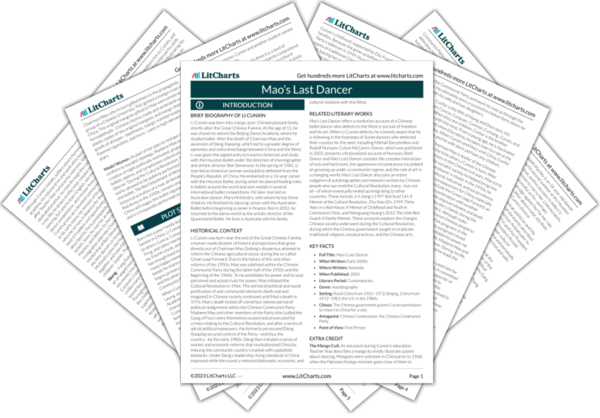Opportunity, Hard Work, and Success
Chosen more or less at random from among his classmates to audition for the Beijing Dance Academy at age 11, Li Cunxin works hard to capitalize on this lucky break. The academy’s curriculum presents a grueling physical and mental challenge to its students, who rise early and practice late to perfect their technique. At first, Cunxin struggles with homesickness and loneliness, but his niang and dia and Teacher Xiao remind him that hard work brings…
read analysis of Opportunity, Hard Work, and SuccessLove and Family
Li Cunxin and his seven brothers grew up in extreme poverty and struggle in a rural Chinese farming commune. But while Cunxin remembers—and clearly describes—the discomforts of his childhood, he paints a poignant picture of a deeply devoted and loving family, too. Dia explains the power of family in a public speech at youngest brother Jing Tring’s wedding in which he describes his children as the “sparks of life” that kept him and Niang…
read analysis of Love and FamilyThe Power of Stories
During Li Cunxin’s childhood, movies are a once-a-year treat. On the chosen day, Chinese Communist Party workers set up a makeshift cinema in the public square of Cunxin’s tiny village to screen recordings of state-produced propaganda ballets and operas. These screenings fire Cunxin’s imagination, but their effect pales in comparison to the legends and folktales he hears from his dia and the Wuho Man, which help Cunxin to understand the world and his…
read analysis of The Power of Stories
Freedom vs. Repression
Li Cunxin grows up in a China controlled by the Chinese Communist Party. Later in his life, he defects to America. Through the contrast between the two parts of Cunxin’s life, the book explores the distinction between the two countries. One is communist, the other capitalist. Neither is perfect, nor wholly imperfect: While Cunxin enjoys the higher standard of living available in America, he remains keenly aware of how far carelessly Americans like Ben…
read analysis of Freedom vs. Repression






